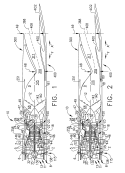How'd you know? I was expecting atleast some kind curve like what the Americans are trying to do.The portion of the exhaust that got shortened was already a straightaway.
You are using an out of date browser. It may not display this or other websites correctly.
You should upgrade or use an alternative browser.
You should upgrade or use an alternative browser.
Chengdu next gen combat aircraft (?J-36)
- Thread starter Blitzo
- Start date
Because the bottom flaps are an extension from the actual exhaust exit? Which we know because we have side and aft profile photos of the first plane?How'd you know? I was expecting atleast some kind curve like what the Americans are trying to do.
You’re missing the point. Even if they did employ an S shaped exhaust the extended bottom flap of the first prototype would have to have been after any S curve because that extended bottom flap is a straightaway. Next time look at pictures of the plane first before panicking about why China isn’t doing what you think America is (I am calling you out on this here because you do this *a lot* and it frankly speaking degrades the quality of conversation).Doesn't mean they couldn't have fitted something like this
View attachment 163515
Sure, I guess you're right. I'm happy as long as whatever they put on there is atleast as advanced as what the US have.You’re missing the point. Even if they did employ an S shaped exhaust the extended bottom flap of the first prototype would have to have been after any S curve because that extended bottom flap is a straightaway. Next time look at pictures of the plane first before panicking about why China isn’t doing what you think America is (I am calling you out on this here because you do this *a lot* and it frankly speaking degrades the quality of conversation).
My two cents:
1 - 2D-TVC replacing flap exhaust could mean greater active pitch control and trim authority needed going forward.
2 - Main gear configuration change means wheel well changes which probably mean IWB optimization.
3 - DSI on side engines probably always planned but needed some flight data to lock down.
IMO 2nd unit will probably be doing IWB / payload / payload release test which requires both a more finalized IWB structure design and increased trim authority to deal with larger load balance variance.
1 - 2D-TVC replacing flap exhaust could mean greater active pitch control and trim authority needed going forward.
2 - Main gear configuration change means wheel well changes which probably mean IWB optimization.
3 - DSI on side engines probably always planned but needed some flight data to lock down.
IMO 2nd unit will probably be doing IWB / payload / payload release test which requires both a more finalized IWB structure design and increased trim authority to deal with larger load balance variance.
But how do you know what the US has is the best for the given application, we don’t know the requirements for both the NGAD nor the J-36. We don’t even have clear imagery of the new exhaust, and conclusions are being jumped that it’s definitively inferior. Engineering is a field of tradeoffs.Sure, I guess you're right. I'm happy as long as whatever they put on there is atleast as advanced as what the US have.
Whatever we put out isn't gonna be the most advanced or the most optimal either. The Boeing NGAD is absolutely gonna have a ton of compromises because if it didn't we literally wouldn't be able to afford more than 2 squadrons at most.Sure, I guess you're right. I'm happy as long as whatever they put on there is atleast as advanced as what the US have.
Main gear configuration change is just strange.My two cents:
1 - 2D-TVC replacing flap exhaust could mean greater active pitch control and trim authority needed going forward.
2 - Main gear configuration change means wheel well changes which probably mean IWB optimization.
3 - DSI on side engines probably always planned but needed some flight data to lock down.
IMO 2nd unit will probably be doing IWB / payload / payload release test which requires both a more finalized IWB structure design and increased trim authority to deal with larger load balance variance.
It would surprise me a lot if IWB optimization and landing gear bay was not optimized before the first prototype. A structural or ground handling problem due to a bad landing gear design could be a thing, pushing for a quick change ?
Anyway... it look that first flight was probably way older than we think.
Last edited:
If we are going by emphasising all aspect stealth and IR signature management (Which I thought was one of the biggest selling point of 6th gen?) then yeah, if the US does go through with designs like those then it's likely going to be better. Even the original buried exhaust would very likely be better. Odd choice to trade off higher overall stealth for maneuverability especially in a plane that seemingly wasn't meant to be extremely maneuverable in the first place and with the usefulness of high maneuverability in future combat being very debated.But how do you know what the US has is the best for the given application, we don’t know the requirements for both the NGAD nor the J-36. We don’t even have clear imagery of the new exhaust, and conclusions are being jumped that it’s definitively inferior. Engineering is a field of tradeoffs.

